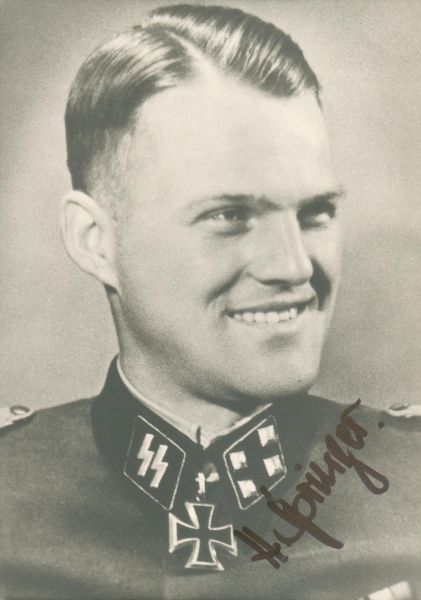Springer, Heinrich Adolf Leopold (Waffen SS)
- Date of birth:
- November 3rd, 1914 (Kiel/Schleswig-Holstein, Germany)
- Date of death:
- October 27th, 2007 (Oelixdorf/Schleswig-Holstein,Germany)
- Service number:
- SS-Nr.: 291.007 // NSDAP-Nr.:
- Nationality:
- German
Biography
Promotions:
00.06.1936: SS-Mann
00.00.1939: SS-Sturmmann
01.06.1939: SS-Standarten-Junker
01.09.1939: SS-Standarten-Oberjunker
09.11.1939: SS-Untersturmführer
09.11.1940: SS-Obersturmführer
09.11.1941: SS-Hauptsturführer
21.06.1943: SS-Sturmbannführer
Career:
00.00.1931: Gymnasium, Meldorf
00.05.1931: Hitlerjugend
01.10.1932: Ausbildung Maurer
00.00.1932: Führer des Jungvolk-Fähnleins „Nord", Hitlerjugend
00.00.1934: Bauingenieur, Staasbauschule Eckernförde
00.06.1936: joined the SS
00.07.1936: SS-Mann, 9. Sturm 9, SS-Standarte 50
03.04.1937-00.10.1937: RAD, Flensburg
01.11.1937: SS-Schütze, 3. Sturm, SS-Standarte 2 "Germania", SS-VT
00.03.1938: campaign in Austria
04.05.1938-00.10.1938: lMG-Schütze, 11. Sturm, III. Sturmbann, SS-Standarte 3 "Der Führer", SS-VT
15.11.1938: SS-Junker, 7. Friedens-Junker-Lehrgang under SS-Hstuf Vinzenz Kaiser, Junkerschule Tölz
16.08.1939-10.10.1939: Zugführerlehrgang Dachau
23.10.1939: Zugführer, 2. Sturm, I. Sturmbann, Leibstandarte SS-"Adolf Hitler", Prague
00.05.1940: SS-Ustuf, campaign in the West
10.06.1940: WIA to his thigh near La Ferte-Milon, France
20.06.1940: WIA to the left hand in the fighting around Clermont-Ferrand airfield and evacuated to SS-Lazarett in Mecklenburg
09.09.1940: SS-Ustuf, Adjutant, I. Bataillon, SS-Infanterie-Regiment LSSAH, SS-VT, Metz
26.12.1940: SS-Ostuf, Adolf Hitler's visit to the LAH for Christmas, Metz
01.03.1941-00.04.1941: SS-Ostuf, Adjutant, I. Bataillon, SS-Infanterie-Regiment LSSAH, campaign in the Balkans - Klidi Pass
21.06.1941: SS-Ostuf, Adjutant, I. Bataillon, SS-Infanterie-Regiment LSSAH - campaign in Russia
00.06.1941: IIa, SS-Infanterie-Regiment LSSAH
08.08.1941: SS-Ostuf, Führer, 3. Kompanie, SS-Infanterie-Regiment LSSAH - Black Sea, Berdjansk, Mariupol and Taganrog
12.10.1941: attack on the Mius river at Nikolajewka
15.10.1941: WIA for the 3rd time to the left upper shoulder near Nikolajewka
17.11.1941: SS-Hstuf, Führer, 3. Kompanie, SS-Infanterie-Regiment LSSAH - Rostov, Don River
19.11.1941: WIA fo the 4th time to the head
21.11.1941: WIA for the 5th time by a Soviet sniper to the shoulder and evacuated by JU52 to theLazarett in Leignitz
23.01.1942: received the RK from Sepp Dietrich at Berlin Lichterfelde
00.02.1942: SS-Hstuf, Führer, 7. Kompanie, SS-Ausbildungs und Ersatz-Bataillon LAH
01.06.1942: SS-Hstuf, Chef, 1. Kompanie, SS-Infanterie-Regiment 1, SS-Division (motorisiert) LSSAH - Kharkov
00.07.1942: refit in France
00.01.1943: SS-Hstuf, Chef, 1. Kompanie, SS-Panzergrenadier-Regiment 1, 1. SS-Panzergrenadier-Division LSSAH - Battle of Kharkov
12.02.1943: severely WIA near Rogan and evacuated
20.03.1943: SS-Hstuf, SS-Panzer-Grenadier-Ausbildungs- und Ersatz-Bataillon I (Berlin)
00.06.1943: SS-Stubaf, appointed IIa, Adjutant, 12. SS-Panzergrenadier-Division "Hitlerjugend"
16.10.1943: joined the 12. SS-Panzergrenadier-Division "Hitlerjugend"
11.05.1944: SS-Stubaf, appointed to the Stab, Reichsführer-SS
01.06.1944: SS-Stubaf, Verbindungsoffizier Waffen-SS, Wehrmachtsführungsstab, Oberkommando der Wehrmacht, Berghof, Obersalzberg then Rastenburg
30.08.1944-05.02.1945: SS-Stubaf, Erster Ordonnanzoffizier (O1), Fieldmarschall Walter Model, Heeresgruppe B
06.02.1945: SS-Stubaf, O1, RFSS Heinrich Himmler, Heeresgruppe Weichsel - Prenzlau
27.03.1945: SS-Stubaf, O1, General Heinrici, Heeresgruppe Weichsel - Prenzlau
27.05.1945: captured at Mariengaard near Felnsburg - British POW
00.02.1946: escaped from POW camp Neuengamme
01.09.1948: Hochbau-Ingenieur, Kiel
15.11.1952: Bauingenieur, Itzehoe
00.12.1977: Technischer Angestellter, Schleswig-Holstein
Do you have more information about this person? Inform us!
- Rank:
- SS-Schütze (Private)
- Unit:
- 3. Sturm, SS-Standarte 'Germania', SS-VT
- Awarded on:
- March 2nd, 1939
- Period:
- Second World War (1939-1945)
- Rank:
- SS-Untersturmführer (2nd Lieutenant)
- Unit:
- Zugführer, 2. Sturm, I. Sturmbann, Leibstandarte SS Adolf Hitler, Waffen-SS
- Awarded on:
- November 9th, 1939
- Period:
- Second World War (1939-1945)
- Rank:
- SS-Untersturmführer (2nd Lieutenant)
- Unit:
- Zugführer, 1. Sturm, I. Sturmbann, Leibstandarte SS Adolf Hitler, Waffen-SS
- Awarded on:
- June 8th, 1940
- Period:
- Second World War (1939-1945)
- Rank:
- SS-Untersturmführer (2nd Lieutenant)
- Unit:
- Zugführer, 2. Sturm, I. Sturmbann, LAH
- Awarded on:
- June 1940
- Period:
- Second World War (1939-1945)
- Rank:
- SS-Untersturmführer (2nd Lieutenant)
- Unit:
- Adjutant, I. Bataillon, LAH, SS-VT
- Awarded on:
- October 3rd, 1940
- Period:
- Second World War (1939-1945)
- Rank:
- SS-Obersturmführer (Lieutenant)
- Unit:
- Adjutant, I. Bataillon, Leibstandarte SS Adolf Hitler, Waffen-SS
- Awarded on:
- July 12th, 1941
- Period:
- Second World War (1939-1945)
- Rank:
- SS-Obersturmführer der Reserve (1st Lieutenant of Reserves)
- Unit:
- Führer, 3. Kompanie, LAH
- Awarded on:
- October 1941
- Period:
- Second World War (1939-1945)
- Rank:
- SS-Hauptsturmführer (Captain)
- Unit:
- Führer, 3. Kompanie, I. Bataillon, Leibstandarte SS Adolf Hitler, Waffen-SS
- Awarded on:
- November 26th, 1941
- Period:
- Second World War (1939-1945)
- Rank:
- SS-Hauptsturmführer (Captain)
- Unit:
- Führer, 3. Kompanie, I. Bataillon, Leibstandarte SS Adolf Hitler, Waffen-SS
- Awarded on:
- January 12th, 1942
Nonetheless his actions at the bridge, though ultimately in vain, in themselves were impressive enough and Springer was given the Knight’s Cross while in the hospital.
- Period:
- Second World War (1939-1945)
- Rank:
- SS-Hauptsturmführer (Captain)
- Unit:
- LAH
- Awarded on:
- May 1942
- Period:
- Second World War (1939-1945)
- Rank:
- SS-Hauptsturmführer (Captain)
- Awarded on:
- September 3rd, 1942
- Period:
- Second World War (1939-1945)
- Rank:
- SS-Hauptsturmführer (Captain)
- Awarded on:
- September 1942
- Period:
- Second World War (1939-1945)
Sources
- Photo 1: Christian Habisohn
- - FELLGIEBEL, W.P., Elite of theThird Reich, Helion & Company Limited, Solihull, 2003.
- MOONEY, PETER, Waffen-SS Knights and their Battles, Schiffer Pub Ltd, 2008.
- Personalakte
- Mooney, P., Dietrich’s Warriors – The History of the 3. Kompanie/1st Panzergrenadier Regiment 1st SS Panzer Division Leibstandarte Adolf Hitler, Schiffer Publishing Ltd., USA, 2004
- Heinrich-Springer.de
- Axis Biographical Research
- Heinrich Springer - Stationen eines Lebens in Krieg und Frieden - Zeitgeschichtliches Zeugnis des SS Sturmbannführers und Ritterkreuzträger der Leibstandarte SS Adolf Hitler - Wehrmacht1945.de
















